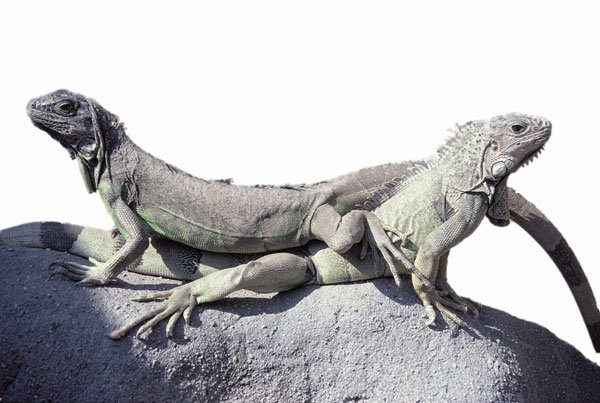What’s got grayish-green scales, a long, forked tongue and is
oh-so-cuddly?
White throat monitors, according to Mason Hyland, a reptile
aficionado who’s raising a breeding pair of the species.
What’s got grayish-green scales, a long, forked tongue and is oh-so-cuddly?
White throat monitors, according to Mason Hyland, a reptile aficionado who’s raising a breeding pair of the species. The 18-year-old Gavilan student hopes their offspring will provide a tidy and steady source of income to supplement his job at Applebee’s. There’s only one problem with this plan: His mom won’t let him bring them home.
Enter Chuck Gray, co-owner of The Reptile Ranch in Gilroy with his wife Laura. In exchange for Hyland’s help cleaning cages and feeding animals, the Grays have been teaching him and his girlfriend Kelly Andolina about the breeding of reptiles.
“I got them about two months ago, but I haven’t named them,” said Hyland, of the pair. “I’m not very good about naming things.”
The aspiring breeder is good at caring for the monitors, though, stopping in daily with tasty treats for his critters like rats, bugs, worms and mice, not to mention portions of eggs and ground turkey. Still, cockroaches are the hands-down favorite.
Hyland, who credits his love of reptiles to his father, got his first snake at age eight. As a young boy, he didn’t share his bed with a fuzzy dog or cat, but a red-tail boa named Ka. Now his collection takes up too much space to store the monitors, who need a weather-controlled cage in order to breed.
Unlike warm-blooded animals, reptiles depend on the season to dictate their breeding patterns, said Gray, and humans must imitate the seasons of the animal’s natural habitat – in this case, Africa – by warming and cooling the cage as necessary.
In the case of the monitors, Hyland and Gray have cooled the cage, since the female monitor produces her eggs in response to a cooling in the weather and the male’s sperm must be cooled as well in order to fertilize the ova, said Gray.
“It’s kind of like you’re God, and that’s the world you’re controlling,” said Gray, who noted that monitors are not deemed ready to breed based on a “potent” age so much as size, as some lizards grow faster than others, in much the same way humans shoot up at different rates.
Unlike humans, lizards never stop growing. Most white throats reach a size of between five and six feet in their 20 to 25 year lifetime, but theoretically, a lizard could continue growing indefinitely as long as it was healthy and had an ample food supply, said Gray.
The monitors Hyland is breeding will be able to lay anywhere between 21 and 35 eggs within six to eight weeks of reaching their optimal temperatures. The offspring that emerge will take between four and five months to hatch, netting $200 to $250 each.
“I want to make sure that they’re really well socialized, said Hyland, quietly reaching into the monitors’ cage. The male thrashes his tail and hisses a warning, but immediately quiets as Hyland places his hand on the back of the animal’s head.
This calming gesture signals that a feeder is present, and the monitor allows himself to be picked up, then quietly rests on Hyland’s hip as the teenager slowly strokes his scaled back.
“It’s sort of like that with a lot of the animals,” Hyland said. “With the snakes, you reach in and touch them on the top of the head, and they know you’re not food, so you can pick them up and put them in their tub to eat while you clean their cage.”
The behavior of a reptile is a bit unpredictable, Hyland admits, but he’s learned to read the warning signs that his monitors give. When the male tires of petting he will press his mouth against Hyland’s hand, signaling that more strokes will result in a bite from is beak-like mouth.
“Reptiles interact with you just like other animals,” said Hyland. “You just have to be patient.”
But plenty of people fear the very animals Hyland loves. Snakes, lizards and spiders all have the ability to terrify some, but Gray said it’s unnecessary.
“The fear of puppies and kittens isn’t like that,” said Gray. “Cats and dogs have been domesticated for thousands of years, but there’s still wild snakes and wild lizards. These things are wild, but as long as you treat them well, they’ll treat you well.”
According to Gray, a reptile’s behavior can be determined by two things: Its care and its personality.
“You have to take care of the animal and provide for its needs or of course it’s going to turn on you,” said Gray. “But you can’t label an animal based on its group. Jungle Carpet Pythons have a reputation for biting, but not all of them want to bite.”
Even so, some people are just more comfortable on the other side of the glass.














